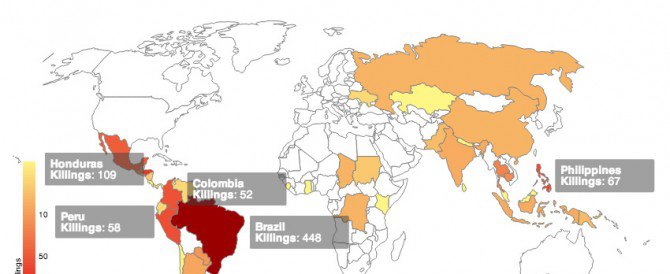A version of this blog was first published on the Guardian website
This week the Intergovernmental Panel on Climate Change (IPCC) confirmed what 99.9% of those who work on environmental issues already knew. We need to change something pretty drastic in the world economy if we want to avoid crashing through the generally accepted safety barrier for life on earth by 2030 – a rise in temperature of less than 2C. The message is finally becoming clear; protecting the environment is not only about polar bears and pandas, it’s about people – and it is the poorest and most vulnerable who are hit first, most and worst.
That same message comes through strongly in the researchGlobal Witness published this week, which identifies a significant recent upturn in killings of the very people who are protecting the environment and land rights. There could be few starker or more obvious symptoms of the global environmental crisis. Yet just as they have been doing for years on climate change, governments are failing to act on or even acknowledge the problem, and in many cases are actively contributing to it.

Huge deals for land, forests and other natural resources continue to be done behind closed doors, without sufficiently considering the social or environmental costs or consulting those who live on the land. When they resist, local communities and indigenous people are branded “anti-development” and bulldozed out of the way, often with the help of the authorities who are meant to protect them. Ironically, such communities typically practise a better and more sustainable approach to development. Those responsible for their persecution enjoy almost total impunity, while monitoring of threats to this particularly vulnerable group is almost non-existent.
Words like “unsustainable” seem woefully inadequate in the face of such tragic circumstances, but the current situation is definitively not sustainable. We can trace this problem back to the same forces that lie behind climate change – soaring consumption in the rich world is driving us far beyond the planet’s natural boundaries. Things like forests and land are finite, but we are liquidating them faster than ever, generally for the short term gain of a few vested interests, and at massive cost to the rest of us.
Powerful elites and their lobbyists continue to play down the risks and convince us that things like fossil fuels and tropical timber are critical to the world economy, so we continue on the same path despite the growing chorus of opinion that it will lead us to disaster.
This must change. Today’s findings are stark, but not surprising. Global Witness first issued a warning that the number of people being killed defending their environment and land were increasing in June 2012, just before the Rio +20 Summit. The report was widely noted, and concern expressed at what we described then as a hidden crisis.
Yet today’s new research shows it remains hidden in plain sight; in the month after Rio, 18 environmental and land defenders were murdered across seven countries. They were just some of 147 known killings of activists in 2012, making it the deadliest year on record to be defending rights to land and the environment.
It is time for governments to act. In December officials will gather again in Lima, Peru for the latest round of climate talks. Unless they change their habits of recent years and act decisively to protect the environment and those most reliant on it, we will once again be left counting the rising cost of their inaction in human lives.